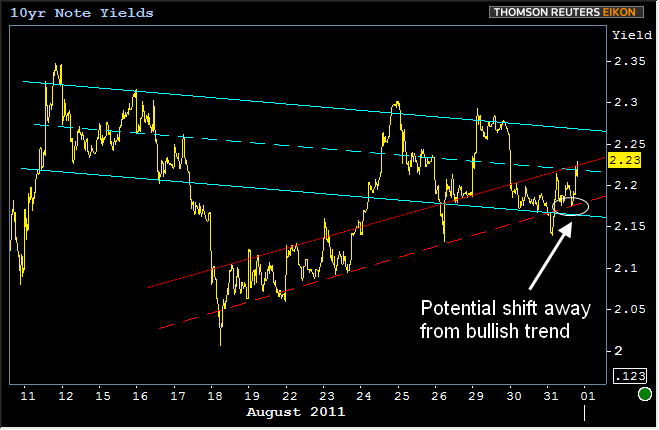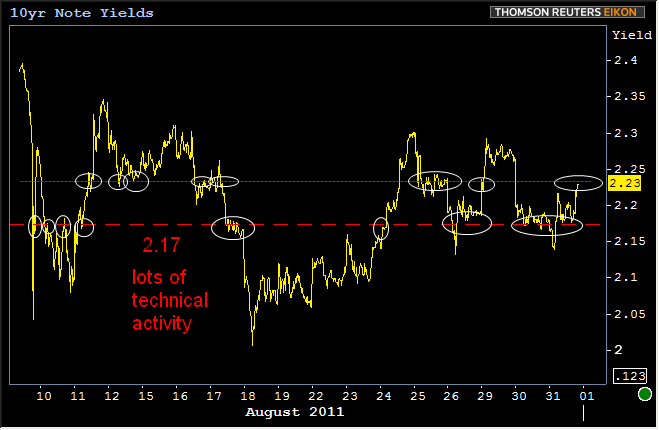Very much a burning question this afternoon, but there are no profoundly alarming answers. Some are short term and ethereal, dealing with things like today's headlines, month end buying (or lack thereof), after-hours illiquidity, and others. But we already put out a reprice alert for temporary factors (twice), so we're going to focus on the big picture.
In fact, focusing on the big picture is pretty much the only thing that makes much sense right now considering our nearness to historical levels and with so much seemingly at stake this Fall (QE or not QE? Refi Program? Recession or no recession? Last time we'll see 4% 30yr rates?). August is the biggest month of rallying in the history of rates, so it's SUPPOSED TO get a bit crazy-making if we try to overanalyze the minutae.
In the spirit of "big picture," we generally favor looking at 10yr notes as the spokesperson for "bond markets" as a whole. We'll dig into MBS in the last 2 charts, but will introduce you to our madness with 10's. Beginning with the most basic construction of recent trading. There's a more than decent chance that things really are as simple as a basic, horizontal range trade. 2.23 has certainly come into play over the past 5 sessions, only allowing yields to pass through on 3 occasions, and a logical point of retreat after failing to break 2.17 (another important technical level).

But even on that chart of flat lines, your eye may already be noticing other trends in play. In fact, there are sideways, bullish, and bearish elements all operating together at the moment. The simple (it really is) reason for this is that the market is in the process of consolidating after the shell-shock earlier in the month. That means there are supportive trends leading the high yields lower and resistant trends pushing them higher. The following chart looks exclusively at these sloped lines.

The teal lines represent the dominant trend channel downward. The slope of those lines = the "pace" of the downtrend. In other words, yields are moving up and down between those lines, but a majority of highs and lows are happening at lines that lie along that same slope. But it's the same story with the red lines. That slope = the pace of the uptrend in yields and that line itself has been a firm source of resistance to gains seeing just the 2 "tests" to breakout on 8/18 and again this morning. But look! Not only did yields test the lower red line this morning, but also the lower teal line! So which trend was being tested? You can see in the white circled portion of the chart that the market ultimately traded as if to suggest that the red line was the focus. The fact that this occurred only minutes before the 3pm close on the last day of the month, 2 days before NFP is certainly enough for a sharp move higher in yield. Well... it seemed sharp in a shorter context, but in the context of the above chart, perhaps you'll agree it looks like a logical return to another technical level (either the mid-point of the downtrend or the high end of the up-trend--- red or teal--take your pick).
Here's a look at the 2.17 and 2.23 levels mentioned above, but zoomed out a bit to show the "sideways" trend that bisects the trends discussed above (again, today could just be this simple):

There's no one right way to look at it when it comes to deciding between "diagonal" or "flat." They're both valid. The more important trend is probably the "sideways" way of looking at things, at least until one of the diagonal trends is broken. This hopefully alleviates some of the inherent panic with losing ground as quickly as we did this afternoon in MBS. Take a look at a longer term chart and see if it makes more sense:

Pretty epic revisiting of a previous ceiling. Classic inflection point. Way to go Fannie 3.5's for exhibiting some excellent technical behavior! But 4.0's are no slouch in that arena either!

As you can see, there was a "then" earlier in the month, we moved on to bigger, better things, and now there is a "now." We've moved back to middle ground. Rates either move higher or lower over the next two days, but either way, markets seem to have set up (as they almost always do) as close to their middle ground as possible.





